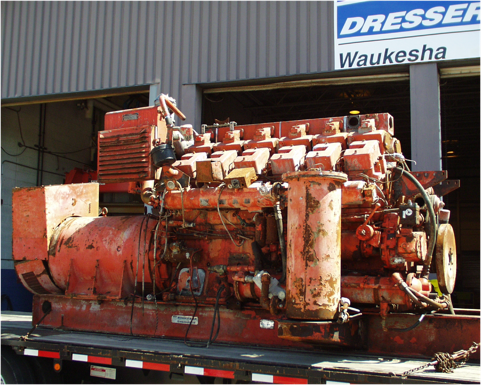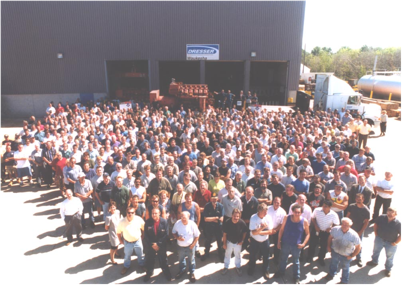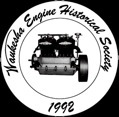A World Trade Center Survivor (added July 2008)

The World Trade Center was a complex of several buildings around a central plaza in New Your City. On any given day, some 50,000 people would work at or visit the WTC. The most notable feature of the complex was the twin towers, each with 110 stories. With a height of nearly 1400 feet, they were 100 feet taller than the Empire State Building. In fact, when they were completed in 1972, (tower one) and 1973 (tower two) the towers briefly held the records as the world’s tallest buildings. Chicago’s Sears Tower, however, would climb to 1450 feet.
To provide backup electrical power for emergency situations, five Waukesha V12 diesel generating units, each rated at 1200 kW, were installed during the construction of WTC. Later, a sixth unit was added. The engine generator units were located in sub-basement 6, the lowest level, on the west side of the tower one.
The world Trade Center Enginator units were sold by a Waukesha distributor, Kraft Power. The original engines, order number E884 (G24713), were shipped in August of 1971. The original engines were VHP L5792DSI rated 1000 KW continuous, 1100 standby. They were later up-rated to 1200 kW standby. Their heat exchanger used water from the Hudson River. A new Enginator, E2832 was shipped in December 1984 and a replacement engine, E3184 was shipped in January 1989.
On February 26, 1993 a bomb planted by terrorists exploded in the underground garage of the north tower. Six people were killed and more than a thousand injured. Six extremist conspirators were convicted of the crime and given prison sentences of 240 years each.
The units ran for 3 hours, 10 seconds after the 1993 bombing. The generator room started to fill up with water from broken piping. After the water rose to the crankshaft centerline area, the engines were manually switched off. Distributor personnel stayed with the engines until the water level was too high and then felt their way to the exit in total darkness. Luckily, their service truck was literally parked right out side the door.
On September 11, 2001, the twin towers of the World Trade Center collapsed in a terrorist attack when two commercial jetliners were crashed into them. More than 3000 people, including fire and rescue workers, were killed. The engines came on line in a valiant attempt to supply emergency power, even if it was for a brief period, because in some early videos the lights were on in parts of the building and complex as the towers started to come down.
The engines had accumulated a few hours over the years and would have remained a source of reliable power for many years to come, had not the events of 911 happened. The distributor had a service contract on the engines since they were installed and was very fond of them - one reason was because they were located in a world famous landmark with high visibility.
Of the six engines, three were declared unsalvageable and immediately scrapped. Two were rebuilt for another productive service life and the third is back home at the Waukesha Engine factory in Wisconsin.

Waukesha Engine employees take a break to commemorate the return of the World Trade Center Enginator. (Circa 2002)
At the same time the towers were collapsing, another interesting drama was unfolding at the Federal Reserve Bank located just two blocks from the epicenter of the disaster. A gold repository, the Bank has four Waukesha VHP 5900DSIU diesel engine generator packages for emergency and standby power. Because of the interruption in the area’s power grid, the engines came on-line and met the emergency power need of the Federal Reserve. The engines became the prime power supplier for the next two weeks. A loyal crew stayed with the engines 24/7 for the entire time.
The salvaged World Trade Center Enginator engine resides at the Waukesha Engine factory today.
Copyright © 2012 Waukesha Engine Historical Society, Inc. All rights reserved
